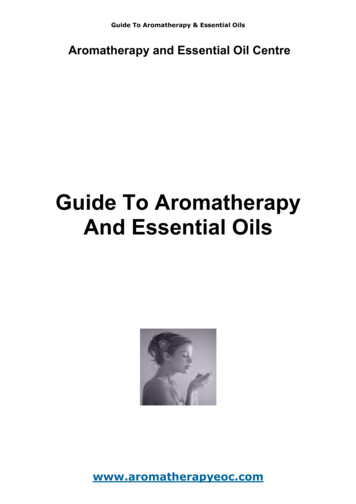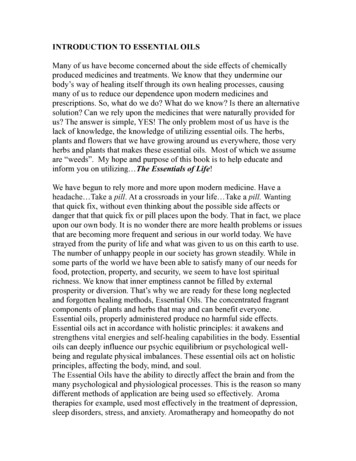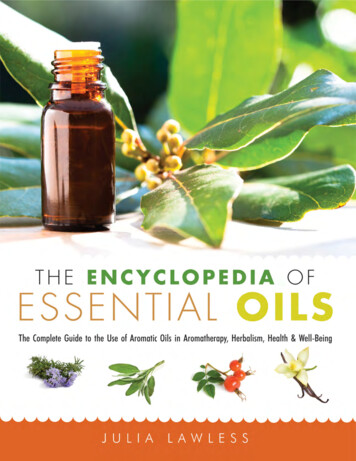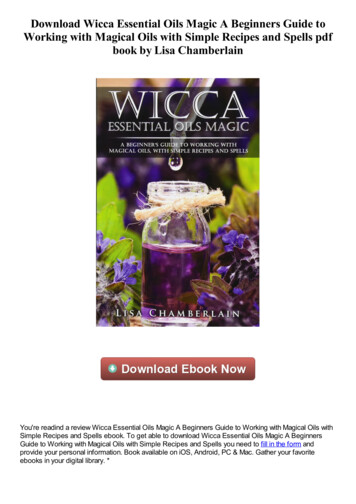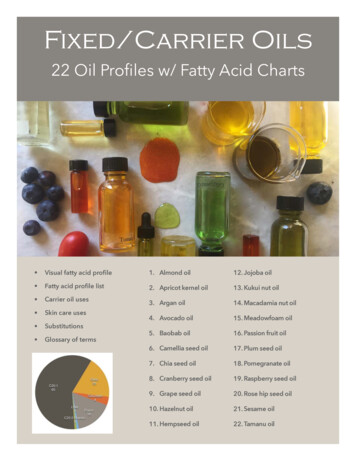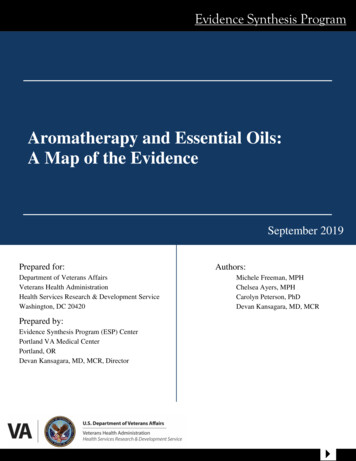
Transcription
Evidence Synthesis ProgramAromatherapy and Essential Oils:A Map of the EvidenceSeptember 2019Prepared for:Department of Veterans AffairsVeterans Health AdministrationHealth Services Research & Development ServiceWashington, DC 20420Authors:Michele Freeman, MPHChelsea Ayers, MPHCarolyn Peterson, PhDDevan Kansagara, MD, MCRPrepared by:Evidence Synthesis Program (ESP) CenterPortland VA Medical CenterPortland, ORDevan Kansagara, MD, MCR, Director
PREFACEThe VA Evidence Synthesis Program (ESP) was established in 2007 to provide timely and accuratesyntheses of targeted healthcare topics of importance to clinicians, managers, and policymakers as theywork to improve the health and healthcare of Veterans. These reports help: Develop clinical policies informed by evidence; Implement effective services to improve patient outcomes and to support VA clinical practiceguidelines and performance measures; and Set the direction for future research to address gaps in clinical knowledge.The program is comprised of four ESP Centers across the US and a Coordinating Center located inPortland, Oregon. Center Directors are VA clinicians and recognized leaders in the field of evidencesynthesis with close ties to the AHRQ Evidence-based Practice Center Program and CochraneCollaboration. The Coordinating Center was created to manage program operations, ensuremethodological consistency and quality of products, and interface with stakeholders. To ensureresponsiveness to the needs of decision-makers, the program is governed by a Steering Committeecomprised of health system leadership and researchers. The program solicits nominations for reviewtopics several times a year via the program website.Comments on this evidence report are welcome and can be sent to Nicole Floyd, Deputy Director, ESPCoordinating Center at Nicole.Floyd@va.gov.Recommended citation: Freeman M, Ayers CK, Peterson C, and Kansagara D. Aromatherapy andEssential Oils: A Map of the Evidence. Washington, DC: Evidence Synthesis Program, Health ServicesResearch and Development Service, Office of Research and Development, Department of VeteransAffairs. VA ESP Project #05-225; 2019. Available sp/reports.cfm.This report is based on research conducted by the Evidence Synthesis Program (ESP) Center located at the VAPortland Healthcare System, Portland, OR, funded by the Department of Veterans Affairs, Veterans HealthAdministration, Health Services Research and Development. The findings and conclusions in this document arethose of the author(s) who are responsible for its contents; the findings and conclusions do not necessarily representthe views of the Department of Veterans Affairs or the United States government. Therefore, no statement in thisarticle should be construed as an official position of the Department of Veterans Affairs. No investigators have anyaffiliations or financial involvement (eg, employment, consultancies, honoraria, stock ownership or options, experttestimony, grants or patents received or pending, or royalties) that conflict with material presented in the report.i
Aromatherapy and Essential OilsEvidence Synthesis ProgramACKNOWLEDGMENTSThis topic was developed in response to a nomination by the Office of Patient Centered Care andCultural Transformation (OPCC&CT) to guide the use of aromatherapy and essential oils in theVHA. The scope was further developed with input from the topic nominators (ie, OperationalPartners), the ESP Coordinating Center, the review team, and the technical expert panel (TEP).In designing the study questions and methodology at the outset of this report, the ESP consultedseveral technical and content experts. Broad expertise and perspectives were sought. Divergentand conflicting opinions are common and perceived as healthy scientific discourse that results ina thoughtful, relevant systematic review. Therefore, in the end, study questions, design,methodologic approaches, and/or conclusions do not necessarily represent the views ofindividual technical and content experts.The authors gratefully acknowledge Robin Paynter, MLIS, and the following individuals fortheir contributions to this project:Operational PartnersOperational partners are system-level stakeholders who have requested the report to informdecision-making. They recommend Technical Expert Panel (TEP) participants; assure VArelevance; help develop and approve final project scope and timeframe for completion; providefeedback on draft report; and provide consultation on strategies for dissemination of the report tofield and relevant groups.Ben Kligler, MD, MPHNational Director, Integrative Health Coordinating CenterVA Central Office, Washington, DCPeter A. Glassman, MBBS, MScChair, Medical Advisory Panel, Pharmacy Benefits Management ServicesVA Greater Los Angeles Healthcare SystemTechnical Expert Panel (TEP)To ensure robust, scientifically relevant work, the TEP guides topic refinement; provides inputon key questions and eligibility criteria, advising on substantive issues or possibly overlookedareas of research; assures VA relevance; and provides feedback on work in progress. TEPmembers are listed below:Leila Kozak, PhDWhole Health National Champion, OPCC&CT – IHCC, VA Puget Sound HCSDirector, Integrative Palliative Care Institute (IPCI)Angie Lillehei, PhD MPH RNChief Integrator, Minnesota Personalized MedicineOwner and Principal, Noctilessence LLCii
Aromatherapy and Essential OilsEvidence Synthesis ProgramLinda L. Halcon, PhD, MPH, RNAssociate Professor Emerita, University of Minnesota School of NursingMargo A. Halm, RN, PhD, ACNS-BCAssociate Chief Nurse Executive, Nursing Research/ EBP & Magnet Director, Portland VAHCSPeer ReviewersThe Coordinating Center sought input from external peer reviewers to review the draft report andprovide feedback on the objectives, scope, methods used, perception of bias, and omittedevidence. Peer reviewers must disclose any relevant financial or non-financial conflicts ofinterest. Because of their unique clinical or content expertise, individuals with potential conflictsmay be retained. The Coordinating Center and the ESP Center work to balance, manage, ormitigate any potential nonfinancial conflicts of interest identified.iii
Aromatherapy and Essential OilsEvidence Synthesis ProgramTABLE OF CONTENTSACKNOWLEDGMENTS . IIABSTRACT . 1EXECUTIVE SUMMARY . 2Introduction . 2Methods. 2Results . 4Figure. Map of the evidence from systematic reviews of inhaled and topical essential oils fortargeted health conditions/populations . 5Discussion . 6Conclusions . 6Abbreviations Table . 7INTRODUCTION. 9METHODS . 10Topic Development . 10Search Strategy . 10Study Selection . 11Data Abstraction . 12Quality Assessment . 12Data Synthesis . 13Rating the Body of Evidence . 14RESULTS . 15Literature Flow. 15Key Question: What evidence is available that examines the effectiveness of aromatherapy oressential oils for health-related indications? . 16Inhaled EO interventions - Psychological outcomes . 21Inhaled EO interventions – Nausea/vomiting . 25Inhaled EO interventions – Pain and other physical signs/symptoms . 26Inhaled EO interventions – Sleep quality . 30Inhaled EO interventions – Global outcomes . 32Inhaled EO interventions – Adverse effects . 32iv
Aromatherapy and Essential OilsEvidence Synthesis ProgramTopical EO interventions . 33SUMMARY AND DISCUSSION . 35Limitations . 36Research Gaps/Future Research . 36Conclusions . 36REFERENCES . 38TABLESTable 1. PICOTS . 11Table 2. Domains for assessing level of confidence . 14Table 3. Populations, health conditions, and/or symptoms addressed in systematic reviews ofessential oil interventions . 17Table 4. Psychological health outcomes in systematic reviews of inhaled essential oilinterventions . 22Table 5. Effects of inhaled EO interventions on nausea/vomiting . 25Table 6. Effects of inhaled EO interventions on pain and other physical signs/symptoms . 27Table 7. Sleep quality in systematic reviews of inhaled essential oil interventions . 30Table 8. Global outcomes reported in systematic reviews of inhaled EO interventions . 32Table 9. Findings from systematic reviews of topical essential oil interventions . 34FIGURESFigure 1. Analytic framework . 10Figure 2: Literature Flow Chart . 15Figure 3. Number of trials of essential oil interventions for targeted healthconditions/populations, by treatment modality . 19Figure 4. Map of the evidence from systematic reviews of inhaled essential oils for targetedhealth conditions/populations . 20Figure 5. Map of the evidence from systematic reviews of topically applied essential oils fortargeted health conditions . 33APPENDIX A. SEARCH STRATEGIES . 41APPENDIX B. STUDY SELECTION . 51APPENDIX C. ASSESSMENT OF CONFIDENCE IN THE EVIDENCE FROMSYSTEMATIC REVIEWS OF AROMATHERAPY AND ESSENTIAL OILS . 53APPENDIX D. PEER REVIEW COMMENTS/AUTHOR RESPONSES. 56v
Aromatherapy and Essential OilsEvidence Synthesis ProgramABSTRACTBackground: The purpose of this review is to provide the Veterans Health Administration (VHA)with a broad overview of the effectiveness of aromatherapy and essential oils (EOs), and thehealth conditions for which these interventions have been examined.Data Sources and Study Selection: We searched multiple databases through February 2019 forsystematic reviews (SRs) of aromatherapy and EOs for health conditions. Using pre-specifiedinclusion criteria, all abstracts and full-text articles were dual-screened for inclusion. When therewere several qualified reviews for the same health condition, we selected a single review basedon its recency, methods, scope, and applicability.Data Abstraction: From each review, we abstracted the focus of the SR, the number of controlledtrials included, combined number of participants, duration of trials, condition treated, andrelevant findings from controlled trials. We abstracted separate data for each of 5 outcomecategories: psychological outcomes, nausea/vomiting, pain and other physical outcomes, sleepoutcomes, and global health outcomes.Data Synthesis: For each review and outcome category we assigned values representing theeffectiveness level of the intervention and confidence in the evidence and used these values togenerate evidence maps. Additionally, we provide a narrative synthesis of the findings.Results: We included 26 SRs representing the most recent and comprehensive evidenceavailable. There is moderate-confidence evidence that aromatherapy is beneficial for pain indysmenorrhea. Aromatherapy is potentially effective for pain in labor/childbirth; blood pressurereduction in hypertension; stress, depression, and sleep in hemodialysis patients; stress in healthyadults; anxiety in perioperative patients; and sleep quality in various populations, with low tomoderate confidence in the evidence. For EOs applied topically, there is moderate confidence inthe potentially positive effect of tea tree oil for tinea pedis. There is insufficient evidence ofefficacy for all other conditions examined.1
Aromatherapy and Essential OilsEvidence Synthesis ProgramEXECUTIVE SUMMARYINTRODUCTIONThis topic was nominated by Dr. Ben Kligler, National Director of the Integrative HealthCoordinating Center (IHCC) and Dr. Peter Glassman, Chair of the Medical Advisory Panel,Pharmacy Benefits Management Services at the Veterans Health Administration (VHA). Thepurpose of this report is to provide a broad overview of the effectiveness of aromatherapy andessential oils for various health indications. We will summarize the findings of systematicreviews in the form of evidence maps that will be used to guide and support decision-makingabout these treatment modalities in the VHA. The key question for the evidence map was: Whatevidence is available that examines the effectiveness of aromatherapy or essential oils for healthrelated indications?METHODSData Sources and SearchesWe developed search strategies in consultation with a research librarian. We searched multipledata sources from database inception through February 2019 for systematic reviews (SRs) andmeta-analyses of aromatherapy and essential oils.Study SelectionTwo investigators independently assessed all abstracts and full-text articles for inclusion usingpre-specified selection criteria and resolved disagreements through discussion and consensus.We included SRs and meta-analyses that included randomized controlled trials (RCTs) ofclinical aromatherapy or topically applied essential oils (EOs) for specific health indications, riskpopulations, or targeted settings such as healthcare waiting spaces. From these SRs, we excludedresults of trials in children, aromatherapy-massage trials without a massage-only control group,and trials that did not control for concurrent interventions. We excluded data from interventionsin which EOs were applied to mucosal membranes, either orally, vaginally, or taken viaingestion.Potentially eligible SRs met all the following quality criteria: 1) clearly reported their searchstrategy and inclusion criteria; 2) performed a comprehensive search of at least 2 electronicdatabases; and 3) assessed the included studies for potential risk of bias and reported thefindings. When there were several qualified SRs of an intervention for the same health condition,we selected a single review to represent the evidence for that health condition or population,based on recentness, methodological quality, scope, and applicability.Data AbstractionFrom each SR selected for the evidence map, we abstracted the following data: targeted healthcondition or population of the SR, intervention modalities and comparators used among trials,number of eligible RCTs and CCTs, sample size, and findings. Data were abstracted by 1investigator and confirmed by at least 1 additional reviewer.We abstracted outcome data in 6 categories: psychological symptoms, nausea/vomiting, pain andother physical outcomes, global outcomes (specifically measures of functional status or quality2
Aromatherapy and Essential OilsEvidence Synthesis Programof life), sleep quality, and adverse effects. If the effect sizes or P-values for the primary trialswere not reported in the SR, we relied on the qualitative summary of findings provided by the SRauthors.Quality AssessmentTo qualify for inclusion in our evidence map, SRs were required to assess the methodologicalquality of RCTs using a standardized instrument, among other criteria. We took the adjudicationsmade by the primary SR authors at face value and used their quality assessments to rate theoverall body of evidence.Data Synthesis and Rating the Body of EvidenceUsing the vector graphics in Microsoft Excel (2016), we generated scatter plots representing thefindings in 2 dimensions: level of effectiveness and confidence in the evidence. Two reviewersindependently assessed the effectiveness of the interventions and confidence levels, based ondata from eligible trials as reported in the systematic reviews. Each bubble represents thesummary of findings for 1 of 5 outcome categories (psychological, nausea/vomiting, pain orother physical, global, and sleep). We did not include harms in the evidence map because theywere seldom reported. See the figure below for the map of the evidence.We classified the effect of the intervention for each health condition and outcome as follows: No effect: a preponderance of null or negative findings. Unclear: the systematic review reported mixed findings for a single outcome, or mixedfindings across multiple outcomes within the same category, with no preponderance ofeither benefit or negative effects. Potential positive effect: multiple outcomes within the same category (pain/physical,nauseas/vomiting, psychological, global health, or sleep) with at least 1 clear finding ofbenefit; or mixed findings for a single outcome with a preponderance of evidence of apositive effect. Positive effect: numerous studies or a large sample showing a positive effect.We classified the levels of confidence in the evidence as follows:High: Consistent findings from at least 2 studies with a large combined sample size andlow risk of bias.Moderate: Evidence comes from a single large study with no major flaws, or from 2 studies with limitations in sample size, study quality, applicability, or consistency offindings.Low: Small combined sample size, or major deficiencies in the body of evidence.Insufficient: The body of evidence consists of only 1 small study or has unacceptabledeficiencies.3
Aromatherapy and Essential OilsEvidence Synthesis ProgramFor the evidence maps, we grouped together studies with either unclear effect or insufficientlevel of confidence into a combined category of unclear/insufficient evidence. We also provide anarrative synthesis of findings according to treatment modality and outcome.RESULTSResults of Literature SearchOur search of electronic databases, bibliographies, and other sources resulted in a total of 1,646citations. After dual review of titles, abstracts, and full-text articles, we selected 25 SRsrepresenting the most recent and comprehensive evidence available on each intervention, asapplied to distinct health-related conditions and target populations.Summary of ResultsTwenty-six health-related conditions/target populations were examined by the 25 SRs selectedfor the evidence map. Twenty-two SRs provide evidence on inhaled EO interventions, whichencompass aromatherapy combined with massage (EO-massage) as well as inhaled-onlyaromatherapy. Three SRs provide evidence on topical EO interventions.Evidence from 171 eligible trials is represented among the 25 SRs. Hemodialysis, perioperativepatients, dysmenorrhea, labor/childbirth, sleep, anxiety, and depression were the most widelystudied conditions and/or populations. Aromatherapy interventions were most commonlydelivered via inhalation, though the method of application varied widely. SRs of aromatherapyfrequently included trials of aromatherapy-massage, which may involve direct dermal exposurethrough the addition of EO to massage lotion or oil or may be diffused in the room duringmassage. There is moderate-confidence evidence that inhaled EOs are beneficial for pain indysmenorrhea. Inhaled EOs have potential benefit for pain in labor/childbirth (moderateconfidence) and for blood pressure reduction in patients with hypertension (low confidence).Two SRs provided low-confidence evidence of potential positive effects on sleep quality invarious populations. There is moderate-confidence evidence that aromatherapy has no effect onanxiety in palliative care. The effects of inhaled EOs are unclear for nausea/vomiting in allstudied populations, and for all other conditions studied. Among the topical EO interventions,there is evidence of potential effectiveness in the use of tea tree oil for tinea pedis and the levelof confidence in the evidence is moderate. The effectiveness of topical EOs is unclear foronychomycosis, acne, and episiotomy wound healing.4
Aromatherapy and Essential OilsEvidence Synthesis ProgramFigure. Map of the evidence from systematic reviews of inhaled and topical essential oilsfor targeted health conditions/populations5
Aromatherapy and Essential OilsEvidence Synthesis ProgramDISCUSSIONThese evidence maps provide a broad overview of the evidence on clinical aromatherapy andtopical EO interventions.The only condition for which we found a preponderance of evidence suggesting benefit was painin dysmenorrhea. We found several potentially promising areas, including pain inlabor/childbirth; blood pressure reduction in those with hypertension; stress, depression, andsleep in patients on hemodialysis; stress in healthy adults; anxiety in perioperative patientsundergoing various surgery types; and sleep quality in various populations. We also foundevidence of potential effectiveness in the use of topical tea tree oil for tinea pedis. In most of theconditions studied, however, we found insufficient evidence to characterize treatment effects.LimitationsEvidence maps such as these are not designed to provide definitive conclusions about benefit,and there are several reasons for cautious interpretation: 1) we relied only on SRs and did notsearch for more recently published trials or conditions for which no SR has been written (so wecannot be definitive in our characterization of the evidence for each condition, nor is this anexhaustive list of conditions/populations for which aromatherapy has been used), 2) we cannotcomment on the magnitude of treatment effect, 3) we relied on others’ study quality assessments,and 4) our measure of the level of confidence cannot approach the rigor represented bystandardized approaches1 given the previously listed constraints. These maps provide only broad“brushstrokes” regarding the potential benefits of these interventions. One should be particularlycircumspect about the “potential for positive effect” findings since these were – by design –weighted toward identifying any potential area of benefit to aid with research prioritization.Similarly, evidence maps provide a broad overview about evidence gaps, but cannot be definitivein determining an absence of evidence. Data for these evidence maps came from systematicreviews; therefore, individual trials not included in prior reviews or areas for which there wereno reviews meeting inclusion criteria are not represented in these evidence maps. It is possiblethat the maps have identified areas of insufficient evidence in which there is individual trial data,or systematic reviews that did not meet our minimum quality criteria.Research Gaps/Future ResearchThe maps highlight many potential areas for future research. The interventions and healthconditions for which there was evidence of a “potential positive effect” may be one place to startto prioritize research, since these findings underscore potentially fruitful areas of research. Thecomparative effectiveness of different, standardized aromatherapeutic approaches should beexamined especially in conditions for which there is potential promise. Future studies shouldcapture potential adverse effects data, and the safety of aromatherapy should be examined inpatients with comorbidities especially those of the respiratory tract. Furthermore, the use of anon-EO fragrance comparator would improve blinding and allow comparison of effects andharms of aromatherapy containing EO versus synthetically generated fragrance oils.CONCLUSIONSThere is moderate confidence that aromatherapy is effective for pain in dysmenorrhea. We foundpotential positive effects of aromatherapy for pain in labor/childbirth; blood pressure reduction in6
Aromatherapy and Essential OilsEvidence Synthesis Programthose with hypertension; stress, depression, and sleep in patients on hemodialysis; stress inhealthy adults; anxiety in perioperative patients undergoing various surgery types; and sleepquality in various populations, with low to moderate confidence in the evidence. For EOs appliedtopically, there is moderate confidence in the potentially positive effect of tea tree oil for tineapedis. There is insufficient evidence with which to determine whether aromatherapy or topicallyapplied EO is effective for all other examined conditions.ABBREVIATIONS TABLEAbbreviationTermADLActivities of daily livingATAromatherapyBPSDBehavioral and Psychological Symptoms of DementiaCCTControlled clinical trialCDSRCochrane Database of Systematic ReviewsCIConfidence intervalCIHComplementary and integrative healthDBPDiastolic blood pressureEBMEvidence-based MedicineEOEssential oilEPDSEdinburgh Postnatal Depression ScaleESPEvidence Synthesis ProgramICUIntensive care unitKQKey QuestionMAMeta-analysisMADRSMontgomery–Åsberg Depression Rating ScaleMDMean differenceMENQOLMenopause-specific Quality of Life QuestionnaireNASNumeric analog scaleNOSNot otherwise specifiedNRNot reportedNSNot significantOBOOil of bitter orangeOPCC&CTOffice of Patient Centered Care and Cultural TransformationPP-valuePBOPlaceboPICOTSPopulation, interventions, comparators, outcomes, timing, setting, and study designptsParticipantsPUQEPregnancy-Unique Quantification of Emesis/NauseaQOLQuality of LifeRCSQRichards-Campbell Sleep QuestionnaireRCTRandomized controlled trialREEDARedness, Edema, Ecchymosis, Discharge, ApproximationROBRisk of biasRRRisk ratio7
Aromatherapy and Essential OilsAbbreviationTermRSCLRotterdam Symptom ChecklistSBPSystolic blood pressureSEStandard errorSMDStandard mean differenceSRSystematic reviewSTAIState-Trait Anxiety InventoryTEPTechnical expert panelTMDTotal Mood DisturbanceTTOTea tree oilUSUnited StatesVASVisual analog scaleVHAVeterans Health AdministrationEvidence Synthesis Program8
Aromatherapy and Essential OilsEvidence Synthesis ProgramEVIDENCE REPORTINTRODUCTIONThe Veterans Health Administration (VHA) is seeking to increase the use of effective newpractices and approaches in health care as part of its current transformation to a more patientcentered healthcare model that focuses on the Veterans’ goals and priorities for their health. Theuse of various low-risk complementary and alternative health interventions has been increasingboth withi
Aromatherapy and Essential Oils Evidence Synthesis Program 1 ABSTRACT Background: The purpose of this review is to provide the Veterans Health Administration (VHA) with a broad overview of the effectiveness of aromatherapy and essential oils (EOs), and the health con
